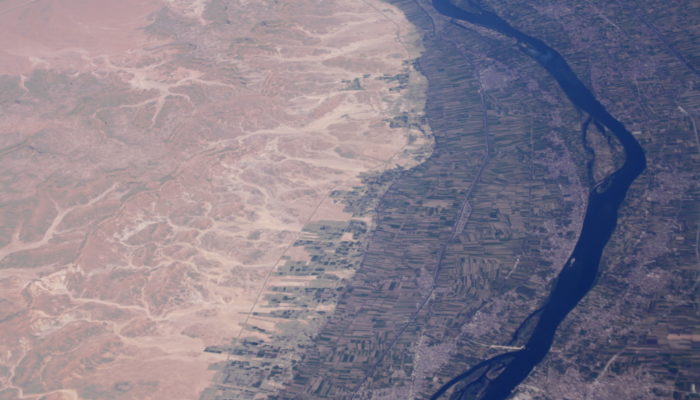
Cairo’s survival was, is, and will be dependent on the flow of the Nile. Since the city was founded in 10th century CE the Nile’s scouring waters have left behind untouched ground onto which the city has spilled and grown. Modern Cairo’s youngest districts are closest to the Nile, founded on earth which was underwater centuries before.
It is the river’s changing nature that made the Nile Valley attractive to ancient settlers. From July until November the valley’s lands were submerged under floodwaters that swept down from Ethiopia’s highlands. These annual floods swamped the valley with three quarters of the Nile’s yearly flow. Far from calamity, the floods were part of an annual cycle which replenished farmland with nutrient-rich alluvium. Throughout the rest of the year the Nile fed a steady low flow, giving the farmers reprieve to sow, grow, and harvest.
This cycle was civilisation-defining. Bronze Age Egypt was an agricultural nation whose society and economy was organised around the river: ancient wheat grains resilient to the hydrologic extremes were favoured. The Nile itself was a transportation network, with boat travel quicker than terrestrial caravan even during times of low flow. Even its tax system was fluvial: as the water levels rose so did the expectations of a strong harvest, and with it taxes. This revenue helped finance a centralised grain storage and distribution system which covered the deficit from years with low floods.
But with natural cycles comes uncertainty.
Turbulent History
Squirming snake-like above the northern highland of Ethiopia, the intertropical convergence zone vacillates throughout the year between about five degrees north and south. The consequent shift in rainfall dictates the low and high flows that make the Nile’s dynamic, fertile system.
But this cycle of low and high flows is bounded between two hydrologic extremes. Climatic influences can upset the cycle, lurching the patterns of rainfall to beget roaring floods or debilitating drought. Such was the dependency of Egyptian nations on the Nile’s cycle that historic upheavals in the river’s flow map well onto episodes of socio-economic decline.
“We can see that three years of low water level of the Nile River caused a period of drought and its consequences of famine, with an increase of a food product price and as consequence, at the end, the death of a large part of the population,” says Francesca Casale, researcher at Politecnico di Milano. Casale is speaking of a three-year drought that gripped Egypt around 1191 CE and caused the deaths of one third of its population.
This story is not an isolated event. “We found a nexus between changes in hydrology and climate in the past and social and economic events like social disorders, conflicts, plagues, famines, and the displacement of population,” Casale continues.
Journeying deeper into the Nile’s history it becomes clear that dramatic shifts in its hydrologic regime underwrote periods of devastating social change. At around 542-600 CE drought helped proliferate a plague which tore through the Byzantine Egypt. At 305-30 BCE the Ptolemaic Kingdom suffered volcano-induced drought, triggering social and political turmoil. Further back, the flooding of the New Kingdom saw farms and settlements abandoned sometime around 1200-950 BCE. A similar crisis was induced when floodwaters twice the magnitude of the Nile’s modern flow swamped the Middle Kingdom around 1700 BCE. And at around 2200 BCE the Nile’s flow plummeted to a 200-year minimum, wracking the Old Kingdom with drought and a period of famine which pushed its population to cannibalism and civil war.
The Geopolitical Watershed
Modern Egypt has since strengthened its hand in the struggle for fluvial control. Since the 1960s the Nile’s damming has ended the annual flood cycle and with it much of the uncertainty it brought.
But upstream Ethiopia has also pursued stability through damming. As Ethiopia’s Grand Ethiopian Renaissance Dam enters its third filling phase the question of Egypt’s water security has inflamed regional tension. Though the risk of a destabilisng flood cycle may have diminished, the fear of escalation between the two nations underscores humanity’s want for stability from a dynamic environment. As the Nile’s flow becomes increasingly influenced by human processes the question of stability becomes geopolitical.
This is made clear through the impact of climate change: as human industry continues to alter the planet’s environmental parameters Egypt has wilted under increasingly hotter and longer summers. In the winter temperature change has become so highly variable that Middle Egypt now experiences hail.
But as climate change brings new uncertainites can past calamity provide clarity?
Casale believes so. Using modern flow and climate data in concert with the expected carbon dioxide emissions for scenario SSP2-4.5, the “intermediate” scenario which exceeds the ambitious targets of the Paris Agreement, Casale could simulate how the Nile’s flow could change in the future.
What she discovered was a story of widespread summer drought. But it was comparing the results with historical flow which struck alarm. “In particular, for irrigation and agriculture, we can compare this [modern] case study with the event of the end of the 12th century when, for the same condition, we have a case of drought or famine and the death of part of the population,” Casale comments.
It may leave you wondering where we can go from here.
Lessons From The Past
It’s important to remember that environmental change was never the sole trigger of socio-economic decline. Poor land management, for example, can increase a population’s vulnerability as slumping agricultural productivity puts less food on tables and less money on the market. A weak economy limits access to key resources and international markets, decreasing the state’s ability to underwrite losses. It also means people have less money in their pockets, making it harder to bounce back from disaster.
Calamities are not born from singular events but are the product of a coupling between environmental and socio-economic vulnerabilities: a ceramic plate dropped onto hard stone will crack web-like from minute fractures otherwise invisible to the naked eye. Similarly, environmental catastrophe breaks through to the surface where socio-economic institutions are at their weakest. In nations wracked by corruption, mismanagement, and conflict the heaviest burden is shouldered by those with the least.
When the Old Kingdom fell into decline it was not solely because of drought. Egypt had been stricken by economic problems for years prior. International trade had broken down, denying the kingdom a key source of revenue. The large estates belonging to favoured courtiers and the priesthood were exempt from taxes whilst the state bankrolled exorbitant temple-building projects. Add into that a looming succession crisis escalating the rivalry between provincial elites, and the drought served as ignition for turmoil.
But as alarming the turbulent history of the Nile’s civilizations may seem it’s important to recognize the many successes where Egypt’s ancient people endured and flourished during times of crises. The long-term grain stores were the product of governance rethinking its policy, one which enabled ancient Egyptians to weather times of drought. Similarly, peoples would alter their patterns of subsistence, changing the foods the ate and the crops they grew. Through adaption they found solution.
Here is where humanity can learn its lesson: many of the key ingredients to socio-economic decline are within our control.
Ancient Egyptian civilisations had no control over the climate. Appeals for rainfall and a bountiful harvest were the domain of the cults and the divine. Today humanity’s global reach means we have a greater a number actions to take to stave off calamity, actions we know which can work. Chief amongst them is limiting our emissions of carbon dioxide.
In modern Egypt farmers have already begun to adapt. Like the ancient Egyptians before this includes changing the type of crop grown. Other adaptions include more modern adjustments, such as disinfecting seeds to encourage germination.
Success was not driven only by local change but also through geopolictical co-operation: at around 1210 BCE the Hittites of Anatalonia were buoyed during a devastating drought by the shipment of grain from Egypt, their erstwhile geopolitical rival. Calamity can not only be a source of destruction but also geopolitical change.
The solution then is not just environmental in nature but geopolitical. The lesson from the civilisations which endured hydrological extremes is a policy of adaption and co-operation.



